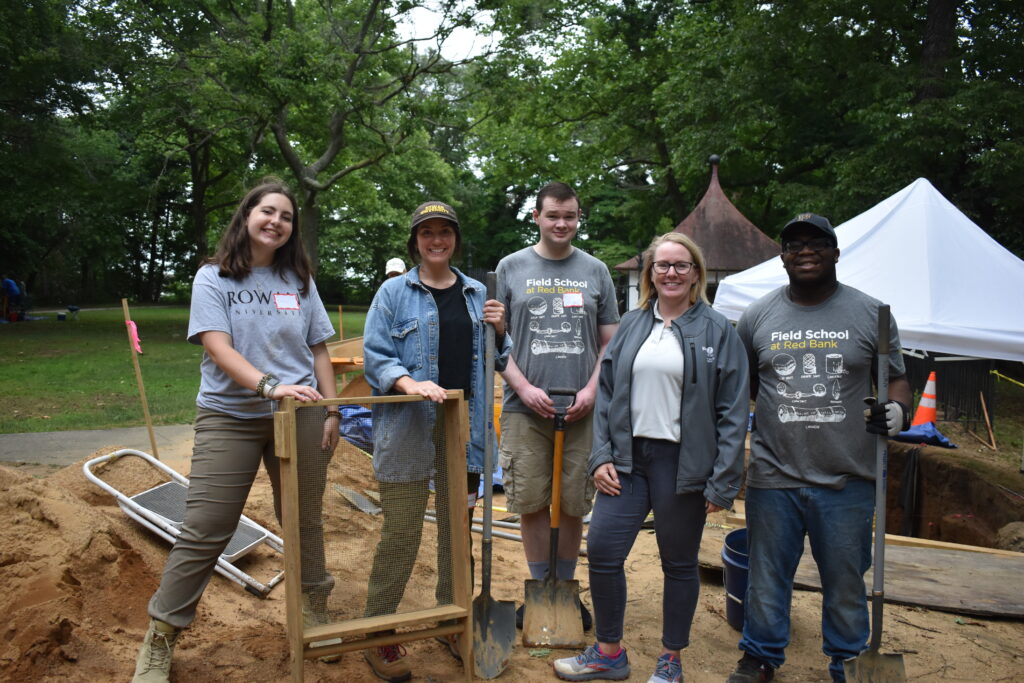
The Red Bank Battlefield air was filled with excitement on the morning of Sunday, June 9, as a group of some 30 veterans gathered under a large open tent and received instructions about digging for artifacts and remains.
“We know that veterans interact with a battlefield differently,” said Battlefield Director Jen Janofsky, who, along with Wade Catts, let the participants know what to expect at the second annual Veterans Archaeology Day. “This is an opportunity to share their service experience and enjoy fraternity with fellow soldiers. I love to get people excited about history.
“Archaeology is like fishing. I hope you catch something today.”
Tasks included screening dirt and moving buckets. Catts said items already found included cannon balls, grape shot, Native American artifacts and the remains of Hessian soldiers killed during the Revolutionary War battle at Fort Mercer in 1777. They had marched from Haddonfield in a futile attempt to take over the fort along the Delaware River in what is now National Park.
“Welcome to all our veterans,” said Kimberly “Max” Brown, executive director of Eternal Soldier in Philadelphia. “This is an opportunity for you to dig in and touch history.”
Brown’s organization worked with Janofsky – who is also a history professor at Rowan University – to coordinate the archaeology event. Eternal Soldier is a veteran-centered organization with programs, tours and workshops at Penn Museum that feature ancient biography, famous narratives, battlefield technology, myth and art.
“Our goal is to empower veterans and help them see that their experiences may differ in detail and technological features, but their emotional, spiritual and psychological experiences have a timeliness that unites all warriors,” Brown explained.
Helping to set up and assist the veterans during the three-hour dig were Janofsky’s students from the Rowan Field School at Red Bank, including Eldridge Lee, Emily Schmidt, Brianna Brida and Braden Wyatt.
“This is the best class I ever had,” noted Brida, who was checking in the veterans. “There is nothing like hands-on history.”
The participants then went to the various dig sites to look for artifacts alongside professional archaeologists, including metal detector specialist Dana Linck, who recently found a piece of the Hessian shiny brass hat plate.
“When the veterans are working at a dig, they are making sense of their own military experience at a site of combat,” noted Brown, who is also a consulting scholar at the Penn Museum. “It teaches them that their actions were on the world stage. It enables them to see the consequences of work and a way of touching history.”
“Veterans connect with battlefields differently from our other park visitors,” Janofsky pointed out. “It’s a way we can thank them and their families for their service. It’s also an opportunity to meet other veterans and share their personal stories of service.”
The history was devastating for the Hessians during the Battle of Fort Mercer. On the morning of Oct. 22, 1777, some 2,000 Hessian troops marched 10 miles from Haddonfield to Fort Mercer. The German mercenaries hired by the English government hoped to overrun the fort and enable ships to get up the river and resupply the Philadelphia-based British Army.
The 400 soldiers defending the fort were the war-hardened troops of the Rhode Island First and Second regiments, and they got a big break when patriot Jonas Cattell ran from Haddonfield through the backwoods ahead of the Hessian troops to raise the alarm, “The Hessians are coming.”
Col. Christopher Greene, a distant cousin of Revolutionary War hero Gen. Nathanael Greene, quickly ordered the patriots – many of whom were Black and Native Americans – to turn around the cannons pointing at the river and face the oncoming attack from land.
By the end of the day, 82 Hessian soldiers lay dead in the trench surrounding the fort after an unsuccessful attempt to scale the walls. Another 228 were wounded in the Battle of Red Bank, and 60 were captured. The heavily outnumbered Continental Army troops reported 14 killed and 23 wounded.
“The Hessians were unceremoniously dumped in a mass grave,” Janofsky stated. “Our goals are to treat the remains with dignity and respect, and identifying specific soldiers and assigning them names.”
She and archaeologist Catts were leading the public participation dig in 2022 – when over four days, some 100 volunteers worked screens and processed artifacts from the quarter-acre trench area deeded to the battlefield in 2021 by a local family – when several femur bones were found on the last day. There has been contact with German historians to possibly find the remains’ descendants.
The next public dig at the battlefield is Family History Day on Sunday, June 23. It is an opportunity for families to discover the excitement of an archaeology project, and children absolutely love archaeology, Janofsky remarked.
“We designed the afternoon to include hands-on activities like screening stations safe for little hands, coloring activities and kid-safe artifacts through our History Cart,” she said. “The Field School students will be working with volunteers from the Archaeology Society of New Jersey to offer an afternoon of fun and educational activities for everyone.”
Admission to that dig is free and the event runs from noon to 4 p.m., rain or shine. For general information, call (856) 853-5120.









